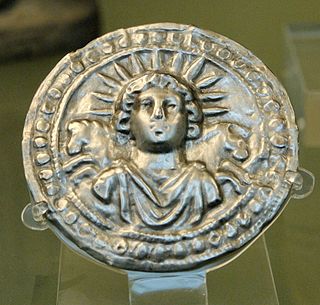The 300s decade ran from January 1, 300, to December 31, 309.
The 310s decade ran from January 1, 310, to December 31, 319.
The 320s decade ran from January 1, 320, to December 31, 329.

Year 321 (CCCXXI) was a common year starting on Sunday of the Julian calendar. In the Roman Empire, it was known as the Year of the Consulship of Crispus and Constantinus. The denomination 321 for this year has been used since the early medieval period, when the Anno Domini calendar era became the prevalent method in Europe for naming years.
The 380s decade ran from January 1, 380, to December 31, 389.
The 180s decade ran from January 1, 180, to December 31, 189.
The 360s decade ran from January 1, 360, to December 31, 369.
The 330s decade ran from January 1, 330, to December 31, 339.
The 340s decade ran from January 1, 340, to December 31, 349.
The 370s decade ran from January 1, 370, to December 31, 379.
The 290s decade ran from January 1, 290, to December 31, 299.
The 280's decade ran from January 1, 280, to December 31, 289.

Year 300 (CCC) was a leap year starting on Monday of the Julian calendar. At the time, it was known as the Year of the Consulship of Constantius and Valerius. The denomination 300 for this year has been used since the early medieval period, when the Anno Domini calendar era became the prevalent method in Europe for naming years.

Year 280 (CCLXXX) was a leap year starting on Thursday of the Julian calendar. At the time, it was known as the Year of the Consulship of Messalla and Gratus. The denomination 280 for this year has been used since the early medieval period, when the Anno Domini calendar era became the prevalent method in Europe for naming years.
Year 277 (CCLXXVII) was a common year starting on Monday of the Julian calendar. At the time, it was known as the Year of the Consulship of Probus and Paulinus. The denomination 277 for this year has been used since the early medieval period, when the Anno Domini calendar era became the prevalent method in Europe for naming years.
Year 362 (CCCLXII) was a common year starting on Tuesday of the Julian calendar. At the time, it was known as the Year of the Consulship of Mamertinus and Nevitta. The denomination 362 for this year has been used since the early medieval period, when the Anno Domini calendar era became the prevalent method in Europe for naming years.
Year 344 (CCCXLIV) was a leap year starting on Sunday of the Julian calendar. At the time, it was known as the Year of the Consulship of Leontius and Bonosus. The denomination 344 for this year has been used since the early medieval period, when the Anno Domini calendar era became the prevalent method in Europe for naming years.

Year 335 (CCCXXXV) was a common year starting on Wednesday of the Julian calendar. At the time, it was known as the Year of the Consulship of Constantius and Albinus. The denomination 335 for this year has been used since the early medieval period, when the Anno Domini calendar era became the prevalent method in Europe for naming years.
Zhang Jun, courtesy name Gongting (公庭), formally Duke Zhongcheng of Xiping or Duke Wen of Xiping was a ruler of the Chinese Former Liang state. During his reign, he at times used the Jin-created title of Duke of Xiping, but when forced to submit to Han-Zhao and Later Zhao, he used the title Prince of Liang. Late in his reign, even when not under Later Zhao's pressure, he claimed the title of "Acting Prince of Liang." During the brief reign of his son Zhang Zuo, he was honored as Prince Wen of Liang (涼文王). The Book of Jin describes Zhang Jun as having an extraordinary appearance and was talented at literature, however he was also an extravagant and dissipated man.
Zhang Shi was the regional warlord and ruler in the Former Liang state. He was the eldest son of Zhang Gui, who was a governor of Liang province under the Jin Dynasty. In 314, Zhang Shi inherited the title Duke of Xiping as well as the governorship of Liang from his father. He was also honored as Prince Ming of Former Liang







